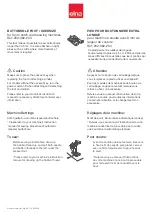
44
EMBROIDERY
— — — — — — — — — — — — — — — — — — — — — — — — — — — — — — — — — — — — — — — — — — — — —
Preparing the Fabric
After attaching a stabilizer material to the embroidery fabric, it is stretched on an embroidery frame.
Attaching an optional stabilizer
material to the fabric
For successful design stitching and to prevent fabric
puckering around the design, iron fusible stabilizer to
the fabric or place non-fusible stabilizer in the hoop
below the fabric.
Memo
z
There are many types of backing and
topping stabilizers with various weights for
the various fabrics that you may be
embroidering. Visit your local retailer to find
the stabilizer that is right for your project.
Note
z
Always use stabilizer material for
embroidery with stretch fabrics, thin fabrics,
fabrics with a loose weave and fabrics where
stitches easily contract.
CAUTION
a
Prepare stabilizer material that is larger than
the embroidery frame being used.
a
Fabric
b
Size of embroidery frame
c
Stabilizer material
b
If you are using stabilizers with adhesive, place
the adhesive surface of the stabilizer material
against the wrong side of the fabric, and iron it
with a steam iron.
a
Stabilizer material
b
Fabric (wrong side)
c
Attached surface
When it cannot be ironed or placed in the
hoop.
For fabrics, such as towels, which cannot be
ironed or for embroidering in places where
ironing is difficult, place the stabilizer
material under the fabric, and stretch the
fabric in the embroidery frame without
attaching the stabilizer.
●
Always use stabilizer material with
embroidery projects. The needle may
break or bend if you embroider without
using a stabilizer material for thin fabrics
or stretch fabrics. Furthermore, the
pattern may not turn out correctly.
2
3
1
2
3
1
Summary of Contents for emore BLMR
Page 1: ......
Page 8: ...6...
Page 16: ...14...
Page 42: ...GETTING READY 40...
Page 74: ...72 EMBROIDERY...
Page 91: ......
Page 92: ......
















































